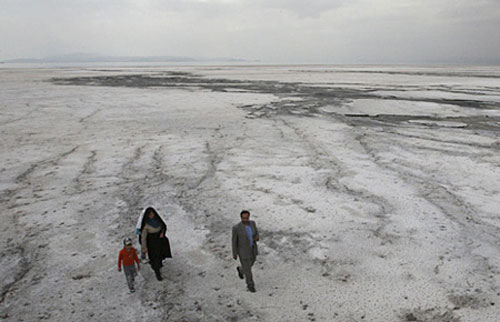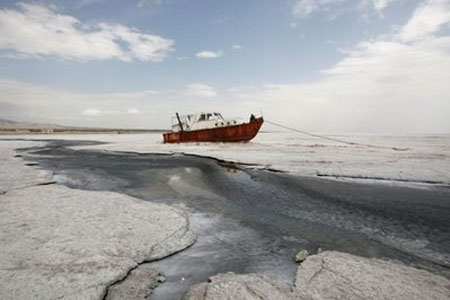Iran's largest lake is turning into ... salt
From the hill, Kamal Saadat looked sadly at hundreds of potential guests, knowing he couldn't take them on a boat trip to enjoy a weekend on Lake Oroumieh, the world's third-largest saltwater lake, as beautiful as painting in the spring.

60% of Lake Oroumieh is lost, giving way to the increasingly thick salt layer.
' Here, the boat is stranded . Unable to move anymore,' Saadat said and pointed out where the boat lay dead in the pile of salt that was becoming more and more frozen and whining about not understanding why the lake was disappearing. .
According to experts, this famous long lake, home to flamingos, pelicans, migratory gulls, is shrinking to 60% and can disappear completely in just a few years.The reason is due to droughts and irrational irrigation policies and the construction of dams to prevent rivers.

A boat suffered a shallow eye on a thickened salt lake.
Just two years ago, in addition to growing almonds and grapes, Saadat made a living by bringing guests to the yacht. But when the lake water decreased with increasing salinity, he found that he had to stop the boat every 10 minutes to check the propeller and eventually he had to give up his second job.
' Tourists will not like such a boring trip,' he said, emphasizing that they must pass hundreds of meters of salt-filled lakes to get from the bridge to the boat.

What remains of a jetty is no longer active.
In April last year, Iranian officials had to shut down at a nearby jetty in Golmankhaneh Bay, due to lack of water in the lake. And now the deepest water level in the lake is only 2m. The pier in Sharafkhaneh Bay and Eslami also faces the same situation.
The shallow lake water also affected the hotel business and tourism activities in the area. Many hotel projects still stalled because investors were hesitating.
In addition to tourism, lakes with increased salt concentrations also threaten the agricultural sector in the nearby region, in northwestern Iran, as the storm sometimes carries salt water to the fields. Many farmers are concerned about their land future, which has been famous for centuries to grow apples, grapes, walnuts, almonds, onions, and delicious potatoes.
' The salty wind will not only affect the surrounding areas but also affect the farming sector in more remote areas,' said Masoud Mohammadian, an agricultural officer in the eastern part of the lake, 600km northwest of Tehran. said.
In April, the Iranian government announced a three-step effort to save the lake, including a program of growing rattan to increase rainfall in the region, reducing water consumption for irrigation systems and supplying water to lakes from sources. distant country.
Some experts believe that the weather control program is just a 'symbolic act' of the government. According to them the best way is to discharge more water that is currently being held by the dams. The amount of evaporation was 3 times higher than the amount of rainwater, placing the rivers has an important obligation to 'feed' the lake. According to an expert, the government must allow the discharge of 20% of the water from the dams to save the lake.

Sea lays are condensed at the edge of the lake.
Song Mostafa Ghanbari, Social Commission secretary saved Lake Oroumieh, believing that the "only way to save" the lake was to transfer water from the Caspian Sea. But this project is considered ambitious, requiring the construction of a pipeline of about 700km long.
In the beautiful, green city of Oroumieh the theme of the lake's fate is frequently discussed in tea and street stalls. Many people are happy about the decision to plant rattan, hoping to increase the amount of rain water for the region. ' This is a right decision. Every night I looked up at the dark cloud coming and told my family that it was going to rain soon ", and on some nights, the rain came, Masoud Ranjbar, a taxi driver said.

Oroumieh is the third largest saltwater lake in the world
But in addition to the debates of state officials as well as local authorities, some people around the area suggested another way to save the lake. Local legend says that wild violet gladiolus has a magical role. This flower is grown every year for a thousand years in Oroumieh, where an Oroumieh princess is killed when she warns everyone in the city about an enemy coming.
One day, when the evening was dyed, Kamal, the boatman, tried to find hope in the flowers. ' You see, the wild violet gladiolus is still about to bloom in the spring. The city and lake can finally live , 'he said.
- The culprit made the
- Brilliant wild salt lake in Crimea
- Stunned with the impressive beauty of 'pink desert' in China
- Rare photos of strange rock salt mines located deep in the bottom of the lake
- The largest salt field in the world is 4,000m high
- The lake of Iranian salt water turned red like blood
- Mysterious about Lake Baikal - The largest lake in the world
- Thousands of bird corpses cover a 200km2 wide lake
- Explain why the lake is red like blood
- Visit the seawater turning factory into the world's largest freshwater
- China's largest freshwater lake shrinks
- The largest lake in Hawaii evaporated after a few hours: What terrible thing happened?
 Is the magnetic North Pole shift dangerous to humanity?
Is the magnetic North Pole shift dangerous to humanity? Washington legalizes the recycling of human bodies into fertilizer
Washington legalizes the recycling of human bodies into fertilizer Lightning stone - the mysterious guest
Lightning stone - the mysterious guest Stunned by the mysterious sunset, strange appearance
Stunned by the mysterious sunset, strange appearance